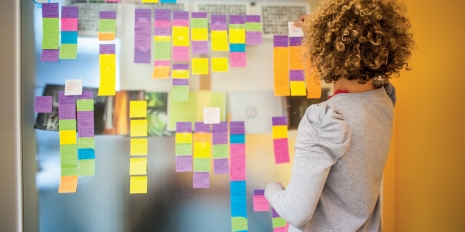
Research is the primary risk management tool you have in product development. It is also the biggest driver of insight and breakthrough ideas. The challenge many people face is doing it in a way that retains creativity and objectivity. Balancing the technical and human centred approaches can be a challenge but the results are worth it.
Understanding people’s needs and requirements is the key to unlocking insights, but is not enough on its own. It must be coupled with a broader understanding of the business, product, and technical context; the product system.
This document sets out a practical approach to undertaking research for product development. It provides guiding principles for primary research and how to interpret information and create insights.
Our approach has been developed from a range of other approaches and our own experiences. It provides a common approach that can be applied across all types of research.
People like dependable, hard statistics to prove either an opportunity exists or that it doesn’t. The problem is that although relevant, statistics are not enough, and very rarely do they provide the understanding and insight we need to drive product development and innovation.
Context is everything
A simple in-context conversation can yield a huge amount of information. It can inform how you think about other people, how they use products as well as their issues, challenges and thought processes. It can irrevocably change your perspective. This can all help your understanding and in turn deliver insights you and your team can use to develop better products and services.
A Three Dimensional Picture
Combining an analytical and humanistic approach is essential to developing a three dimensional picture to establish what the real opportunities are. Often facts, figures and observations combine to provide powerful indicators about gaps in the market or provide a compass bearing for your activity.
Your Best Risk Management Tool
Research is, put simply, the best risk management tool you have. Taking the time to look without preconceived ideas (not easy!) helps to give a more accurate picture of what you’re looking at.
It Does not Stop at the Start
Our understanding changes over time, and it is vital that we continue to iteratively research and further develop our understanding during the program of work.
Be Prepared to be Wrong
We all like to be right. However in more occasions than I care to remember we thought we had an accurate picture and it turned out to be wrong, even with a lot of research. Being open and not dogmatic will improve your chances of delivering something successful.
Our whole approach to product development is underpinned by this anonymously authored simple research loop.
Research is the ‘systematic investigation to establish facts or reach new conclusions’. It can be informal, or formal, qualitative or quantitative. It can be technical, or human/user-centred. The goal is to learn about the context with an open mind to develop a greater understanding.
Understanding is the precursor to Insight, we find that as we learn our understanding develops to the point that insight is possible. It is unerring how many times, if the work is done well and with an open mind, it will yield stunning outcomes.
Insight is the ‘understanding of specific ‘cause and effect’ in a context’. Insight is something that often emerges during or after research and should always be documented. It is when suddenly everything comes together into a form we can understand and communicate.
This research loop is iterative, and is used throughout the development process to deliver fresh insight into the process. It does not stop once we have made the major breakthroughs.
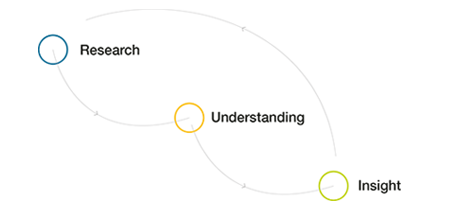
The Broad Process
The process of turning research into insights is generalised into four stages: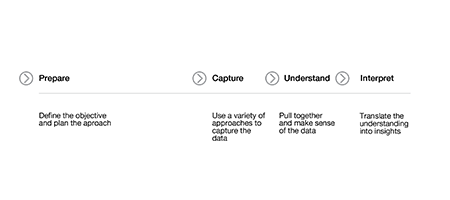
How do you plan for insights?
Below is a framework to plan research activities. The key is to plan for insights and not just the gathering of research data.
This framework is used to plan and clarify the scope and define the resources required to undertake the task at every stage.
This information is captured in a one-page outline which is an effective communication tool for project stakeholders and provides clarity for the research team.
The synthesis and insight stages, where research is translated into insights, are energy intensive and often a challenging task. The work should be planned accordingly to allow sufficient time and resources, as this is where value is created.
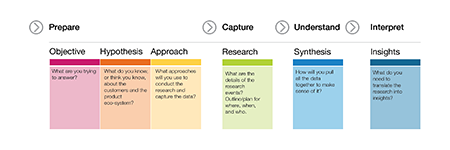
The amount of time, energy, and money that you invest in the research phase of a project should be proportionate to the degree of change that you are driving for. This affects the overall size and scope of the project. For fundamental breakthroughs, a large research base would be desirable to maximise your chances of uncovering new insights and developing breakthroughs. Conversely, even for small projects that perhaps are aimed at iterative development, a small targeted research phase will increase the project’s success, if managed and used effectively.
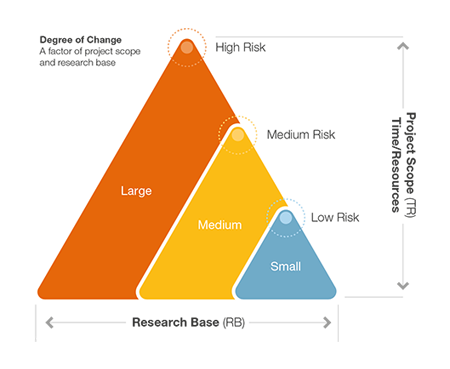
Outline the questions you are trying to answer – what do you need to know at this point in the product development process?
The objectives should be relative to the scope of the project – an objective that is too broad will be unachievable.
Define the different research streams and determine the objectives for each. For example you may have a customer research stream, a technical research stream, and a competing product or market research stream.
Begin by recording your hypotheses for each research stream.
Hypotheses are the things you know and the things you think you know. These hypotheses will drive the research to query whether they are right or wrong assumptions. The research process will essentially test your understanding of your customers and the product ecosystem.
For customer research, build hypotheses around the following aspects of your customer’s experience with the product or service you are researching:
During product development it is dangerous to assume these outcomes because this suggests you are proceeding with an unqualified opinion. Hypothesise, test, and understand instead.
Define the methodologies for how best to conduct the research.
Selecting the most appropriate method(s) is important and is strongly related to the objective. Consider which is the best way to interrogate your hypotheses.
Research methods fall into four high level categories: observational, interviewing, surveying, and desk-top research. These can be deployed as separate methods or combined to gather more data.
Observational research
Watching and recording people’s behaviour in context
Interviewing
Meeting and questioning people about a contextual topic, they may be experts or customers
Surveying
Quantitative surveying can provide statistical metrics on predefined questions
Desktop
Predominantly web-based research drawing information from a wide range of media
In the planning phase, use the framework to outline the specific details of the research sessions – build the action plan. Think about how you will access these people? Do you need to recruit? What are the recruitment criteria? Consider where the research should be undertaken – location can provide valuable insights into people’s natural (and most comfortable) environments. Where can you source technical and market information?
In this planning phase it is important to match the research to your project scope.
The most important question to answer during research is ‘why’. Why is someone saying what they are? Why is that person behaving how they do? Why are the technical issues occurring? Probe and interrogate during research sessions to get to this point. Angle the questions and lines of inquiry to understand ‘why’.
The goal of synthesis is to bring together and combine the information into a more connected whole and, by doing so, take a more holistic approach to assessment and analysis in order to make sense of the data you’ve gathered.
The research process will generate vast quantities of data and fragments of information that initially appear unrelated or disconnected and have to be interpreted and translated into useful information and valuable insights. This is often the most challenging part of the process but it holds the most value.
The synthesis stage makes sense of the masses of research data. It’s both a qualitative and analytical process that involves bringing the information together, clustering common connected or relating items that influence each other and then filtering, grouping, and organising. Work in groups quickly after the capture stage to understand the data while it is fresh. The longer you leave it the more you’ll lose the true meaning.
When the information from one or more of your research streams is complete and recorded, it’s time to start generating insights.
This is best done in a small team session with all participants having a full understanding of the research findings prior to the session. The session will generate fundamental insights and ideas that can then be crafted into well articulated and framed insight statements.
Frame Insights & Point of View Statements
Once you have identified the underlying problems, issues, and forces, frame these by writing a succinct problem statement for each – normally there is more than one, but a single statement is OK. With each problem statement, frame a point of view statement. This is about capturing your belief and point of view of the problem, why it’s really a problem, and then how this might be overcome.
The goal here is to really cut to what you think is the core problem, the epicentre of it, and then frame your point of view for why it’s a problem. This will help you take a position. It also helps you to move from ‘information insights’ to ‘what if insights’ to further close your knowledge gaps.
What If Insights
With your point of view statements, it’s important to explore and define a series of ‘what if’ questions. ‘What if’ questions help you to look at the core problem differently and by doing so gain greater insight? With a series of ‘what if’ questions you can test your insights with more research. They will help you to better understand whether the core problems that you have identified are indeed accurate – your hypothesis of the problem – and whether your positioning point of view may offer new benefit.
In our experience the keys to successfully implementing an insightful research process are:
“You can’t study the darkness by flooding it with light.” - Edward Abbey
Here is a list of guiding principles when conducting customer research:
Here is a selection of tools to use when conducting research:
“If you do not change direction, you may end up where you are heading” - Lao Tzu
Developing new products and services and taking them to market is among the more difficult things you can do. There are a lot of variables and things are constantly changing. We have tried to develop processes that recognise this, and work with it not against it.
It acknowledges the first principle of innovation, which is that change is the only constant.
Creating a culture, which rewards dynamic thinking and embraces the likely event of change, will deliver benefits for your company. Too many companies reward delivery of a plan set in stone as opposed the plan that improved or the opportunity that changed.
This document reinforces what we believe are the four tenets of innovation:
Comments
Post new comment